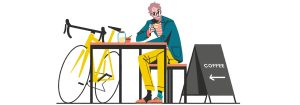Metabolism Hacks for Cyclists: Dr Hussain Al-Zubaidi’s Guide to a Leaner, Faster Body

In this article, YJ x BTF Age group ambassador, Hussain Al-Zubaidi, gives us the lowdown on the importance of a healthy body composition, including his top five strategies to help you improve yours.
Many of us track our weight, but does this tell us the whole story? Although useful it does not give us an idea of the body composition. You can have a healthy body mass index but only achieved through being under muscled and in fact have a high body fat percentage. The quantity of fat we hold regardless of our overall weight is an independent risk factor for developing several conditions including, type 2 diabetes, cardiovascular disease, and liver disease. But a health body composition can lead to increased athletic performance as well.
As a lifestyle physician I care more about what you are made of than what the scales say. This is not a specific weight but instead a healthy lean body composition. Over the last few years, I have gained weight but reduced my body fat percentage. It is important to note woman naturally have higher body fat percentages and dropping below 13% is likely to be associated with potentially detrimental effects on your hormone cycle.
To help you achieve a healthy body composition this I have 5 handy strategies.
Nutrition is key. The focus of your daily diet needs to revolve around nutrient dense and calorie sparse foods. Harvard school of medicine conducted a large-scale study (Mozaffarian et al., 2011) looking at 120,000 men and women and found that the quality of the food consumed had a significant role in determining body composition. Ultra-processed foods are one to avoid. Designed to be as consumable as possible so people keep buying them, they are high in calories and generally low in nutrients. They cause big sugar spikes and stimulate your body to deposit a large amount of the energy as fat. There has been a significant rise in consumption of ultra-processed food (UPF) in recent decades. Over 50% of the food bought in the UK now consists of ultra-processed foods. This compares with 14.2% and 13.4% in France and Italy respectively. If you want to boost your metabolism and create a leaner body composition my advice would be to swap out the food that comes in a packet and incorporate real whole fruits, vegetables, nuts, and seeds.
Another aspect of diet is to ensure you have the nutrients required to allow you to achieve the other aspects like physical activity. Ensuring you correctly refuel and support your body for your next workout is so important. Foods high in trans-resveratrol (e.g., grapes), nitrates (e.g., beetroot) and curcumin (e.g., turmeric) are just examples of important components.
Did you know that our muscles are metabolically active organs? Alongside the liver they help control our blood sugar levels and studies have shown having sufficient muscle bulk reduces your risk of type 2 diabetes and fatty liver disease. Think of them like sponges. They store sugar, so when you have glucose spikes after a meal, individuals with good amounts of muscle mass have larger sponges to absorb the circulating sugar and therefore prevent excess being stored as fat. So, start strength training! It is for ALL not just body builders…
Over the last 70 years we have seen ever increasing food abundancy and ease of access. The ease at which we can now get food is astonishing. I remember watching the recent World Cup, and there were frequent adverts encouraging you to not bother running for your takeaway but to just click some buttons on your phone and it will come to you. A stark contrast to the athletes we were watching on screen. In addition, the sharp rise in addictively designed ultra-processed foods with greater calorie densities than the food our ancestors ate for majority of the last 200,000 years means we have outgrown our evolutionary appetite control mechanisms. These mechanisms are designed to operate with real whole food which has far lower calorie density. Meaning the same volume of food has less calories contained, allowing for stomach to stretch and release gut hormones which tell our brains we are full.
So how to avoid overeating? Learn the difference between belly hunger and head hunger. Look to eat when you are hungry rather than automatically at set times of the day. Slow down the meal and avoid being distracted e.g., reading emails while doing it. This is all called mindful eating and been shown to help reduce overeating.
It is not just what you eat that counts but when you eat. Some key rules I follow that have been shown to positively influence your metabolism to promote a lean body composition.
Eat carbs early: Your carbohydrate stores are used during the night therefore a good time to consume it is in the morning to ensure you adequately refuel to have the energy for a productive day. Protein is particularly useful later in the day to maximise muscle regeneration in the evening and throughout the night.
Avoid eating too close to bed: Promotes fat storage, especially if carbohydrates.
Eat during exercise: many think that by avoiding eating during their workout this will cancel out the calorie burning effect. But in fact, a study by Colorado State University showed that those that ate during a workout consumed less overall for the rest of the day. Although more fat is burned during a workout without nutrition taken, the same study found that there was greater fat burning after a nutrition filled workout.
There is no getting round it but the only way to have a lean healthy body is to put in some hard work. Your workout schedule should include on top of your standard run, cycling or triathlon training:
Strength
A crucial component. If you hate the gym, try resistance bands or kettlebells. The key here to achieve voluntary muscle failure. Aka do a motion until you find it to hard to continue. Select a weight where you achieve that in a sensible number of sets and reps. Try and work all the key muscle groups through the week. Progression in difficulty is important to achieve the same effect going forward. Remember our muscles are metabolically active sponges so let’s build them up! Not only does this promote a healthy body composition but also aids injury prevention, improved performance and a key pillar of health longevity.
Reduce sedentary time
Even if you do plenty of workouts excess time spent sat down sends all the wrongs signals to our metabolism, putting it into standby mode. Use apps or set reminders to get you up and moving every 20 minutes if even for 10 seconds. I can’t tell you the number of triathletes that are active coach potatoes! Reducing sedentary time also will improve joint flexibility and injury rates.
Achieving a lean body is not easy. There is not magic bullet nor single intervention. It takes numerous small steps put together to make a staircase to your end goal. Derive pleasure from the journey you take rather than reserving it for getting to a destination. Be kind to yourself along the way and continue to strive towards it. A key tip is not making any lifestyle change which you can’t see yourself doing long term.






